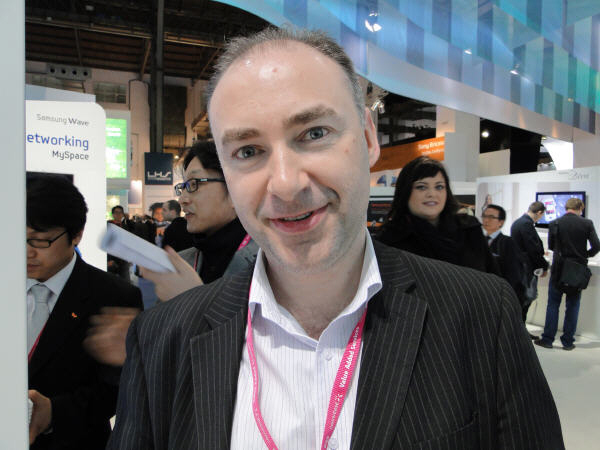MOBILE WORLD CONGRESS 2010, BARCELONA – For something invisible, sentiment behind Near Field Communication (NFC) was very visible at the Mobile World Congress this year, with everyone from phone manufacturers to software start-ups pushing for the arrival of the mobile wallet.
NFC is a short-range, high-frequency, wireless communications technology that enables the exchange of data between devices over some 10 centimetres (four inches) apart. The technology could enable the growth in the market for contactless credit cards and other forms of identification and transaction.
The technology is already in use in two towns in Ireland – Dundalk and Tuam – as well as across 32 Insomnia Cafes around Ireland, not to mention various Londis, Munchies and Eddie Rockets outlets via former Alphyra CEO John Nagle’s firm, Zapa Technology.
According to the global head of mobile products at consumer electronics giant Samsung, Chris Evans, NFC will represent a step change in data communications – not to mention commerce – as we know it.
NFC was in plenty of evidence at the GSM Association’s Mobile World Congress in Barcelona. Everything from proving identity cards to buying coffee utilised NFC.
First-ever SIM-based NFC payments pilot
GSMA, Samsung Electronics Co. Ltd., Telefonica, and Visa, together with Giesecke & Devrient, Ingenico, ITN International and La Caixa, announced the arrival of contactless mobile payments at Mobile World Congress in Barcelona this year. The companies unveiled the result of months of collaboration and have brought the first-ever SIM-based NFC payments pilot to Mobile World Congress.
The participating companies provided more than 400 NFC handsets to guests for use at the congress. The Samsung Star NFC handsets contain Telefonica SIM cards from O2 pre-loaded with €60 airtime credit, as well as a La Caixa Visa Mobile Payment Application. Participants used their NFC phones to pay for food and drink up to a value of €75 at more than 30 merchant locations around the congress.
Evans showed me how NFC content could be accessed instantly by a handset by placing the phone directly over my identity badge. The device was able to grab various data sets, including name and email address.
“We are investing a huge level of R&D in NFC,” Evans said. “This year, NFC will gain momentum and over the next five years we see it becoming more widespread than even contactless payment cards because of the ubiquitous nature of mobile devices.
“The key is getting the general ecosystem working together. It requires the banks, credit card issuers like Visa, and of course various handset manufacturers and technology providers working together.
“In five years’ time we see people carrying NFC on their mobile devices rather than credit cards.”
“We are hoping that this year there will be an all-in effort to see the commercial launch of NFC.”
NFC in Ireland
NFC is already operating commercially in Ireland and is enabling towns like Dundalk and Tuam to help local merchants retain trade in the town by providing NFC-based loyalty cards that at present punters can simply stick onto the back of their mobile handsets.
“Some 80pc of regular loyalty customers at Insomnia coffee shops now have our Zapatag on their handsets,” explained Donal McGuinness of Zapa Technology who added the company has made NFC available as an app on the iPhone and the BlackBerry smart phone.
“In a couple of years we envisage all tickets for things like concerts and football matches being sent over the air by NFC to allow people entry to events. We see contactless credit and debit cards being stored on mobile devices and people using their train and plane tickets this way.”
McGuinness’ colleague John Wall said he saw the use of NFC tags as a transition until the technology becomes more prevalent in smart phones. Zapa’s technology currently features as apps on all smart-phone devices, bar the Android at present.
“The next five years will be all about building out the ecosystem, getting the banks on side and ensuring that this secure, accurate form of payment gets widely adopted. We feel by helping Irish towns retain trade we’re off to a good start,” Wall said.
By John Kennedy
Photos: (Above) A close look at Irish firm Zapa Technology’s NFC app on a BlackBerry device. (Below) Samsung’s global head of mobile products Chris Evans
